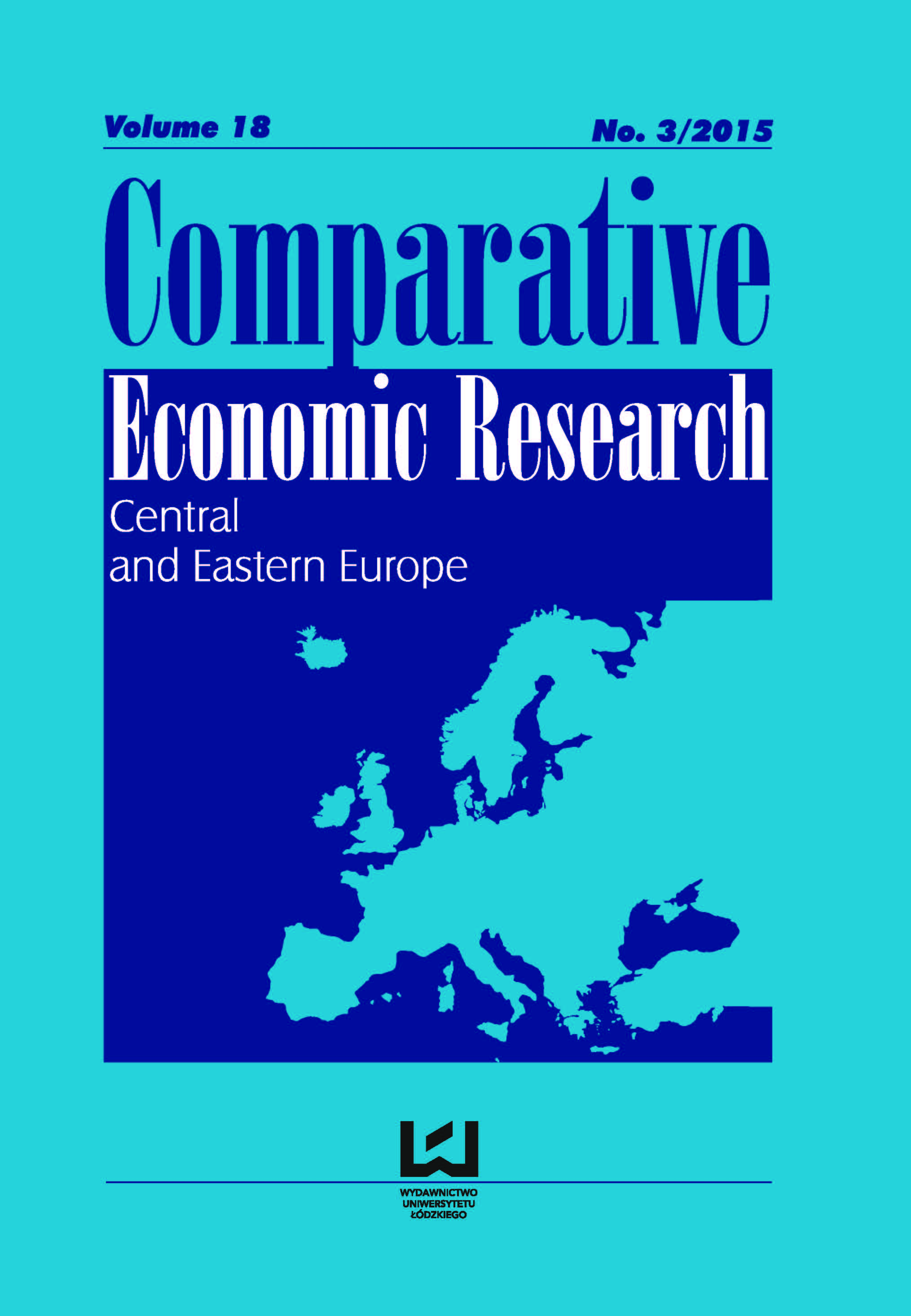Specificity Of Long-Term Unemployment Risk Among Creative Economy Workers
DOI:
https://doi.org/10.1515/cer-2015-0020Keywords:
Creative economy worker, Long-term unemployment determinants, Labour market policyAbstract
This paper investigates the determinants of long-term unemployment in Poland for workers in the creative economy. Over 2,100 unemployed artists, journalists, architects, designers, craftspeople and creative industry technicians registered in public employment agencies are examined to discover the relationship between the probability of long-term unemployment and basic socio-demographic variables, human capital characteristics, as well as type of the local labour market. The outcomes based on the sample of creative workers are compared to a study of almost 44,000 registered unemployed representing all professions. Results indicate that such characteristics as: male gender, age under 30, married, first unemployed registration within the last three years, extensive work experience, high qualifications and multi-skilling each considerably decrease the likelihood of being unemployed for more than 365 days, both among creative workers and among all unemployed. The strength of this influence, however, differs within these two groups, with some co-variates significantly affecting the likelihood of long-term unemployment in the general sample. For example health, having children, or a willingness to take any job all appear to be non-significant for creative workers.
Downloads
References
Alper N. O., et. al. (1996), Artists in the Work Force: Employment and Earnings, 1970 to 1990, ENA Research Division Report #37.
Google Scholar
Alavinia S. M., Burdorf,A. (2008), Unemployment and retirement and ill-health: across-sectional analysis across European countries, ʻInternational Archives of Occupational and Environmental Healthʼ, 82 DOI . doi: 10.1007/s00420-008-0304-6
Google Scholar
Australian Council of Social Services (2005), Measuring Long Term Unemployment in Australia. Strawberry Hills, NSW, Australian Council of Social Services.
Google Scholar
Benhamou F. (2000), The Opposition between Two Models of Labour Market Adjustment: The Case of Audiovisual and Performing Arts Activities in France and Great Britain over a Ten Year Period, ʻJournal of Cultural Economicsʼ, 24.
Google Scholar
Bridgstock, R. (2011), Skills for creative industries graduate success, Education + Training, Vol. 53, No. 1.
Google Scholar
Clarence E., Heikkilä S. (2013), Successful Methods for Getting the Long-term Unemployed into Work: A Short Overview, OECD LEED Trento Centre for Local Development.
Google Scholar
Comunian R., Faggian A., Jewell, S. (2011), Winning and losing in the creative industries: an analysis of creative graduates’ career opportunities across creative disciplines, ʻCultural Trendsʼ, 20:3-4, DOI: . doi: 10.1080/09548963.2011.589710
Google Scholar
Di Domenico G., Gasparini C. (2008), National Approaches to the Long-Term Unemployment as a Target Addressed by Public Employment Services: General Framework, Case Studies and Significant European Experiences [in:] Di Domenico, G, Spattini, S. (eds.), New European Approaches to Long-Term Unemployment. What Role for Public Employment Services and What market for Private Stakeholders?, Kluwer Law International, Alphen aan den Rijn.
Google Scholar
Dolny E., Wojdylo-Preisner M. (2014), Zarys koncepcji badań terenowych (Outline of the field research), [in:] Bronk, A., Wisniewski, Z., Wojdylo-Preisner, M. (eds.), Ryzyko długotrwałego bezrobocia w Polsce. Diagnoza i metody zapobiegania (Long-term unemployment risk: diagnosis and methods of prevention), Ministerstwo Pracy I Polityki Społecznej i Centrum Rozwoju Zasobów Ludzkich, Warszawa 2014.
Google Scholar
Dougherty, Ch. (2007), Introduction to econometrics, Oxford University Press.
Google Scholar
Dubina I.N., Carrayannis E.G., Campbell, D.F.J. (2012), Creativity Economy and a Crisis of the Economy? Coevolution of Knowledge, Innovation, and Creativity, and of the Knowledge Economy and Knowledge Society, ʻJournal of Knowledge and Economyʼ, 3 DOI . doi: 10.1007/s13132-011-0042-y
Google Scholar
EAEA (2001), Study relating to the various regimes of employment and social protection of cultural workers in the EU.
Google Scholar
European Commission (2012), EEO Review. Long-term unemployment 2012, DG for Employment, Social Affairs and Inclusion, September.
Google Scholar
Eurostat (2007), Cultural Statistics, European Communities, Luxemburg.
Google Scholar
Garrouste, C., Kozovska, K., Perez, E. A. (2010), Education and Long-Term Unemployment, European Commission, Joint Research Centre, Institute for the Protection and Security of the Citizen.
Google Scholar
Heilbrun J., Gray Ch. M. (2001), The Economics of Art and Culture, Cambridge University Press.
Google Scholar
ILO, OECD, IMF, the World Bank (2012), Boosting Jobs and Living Standards in G20 Countries, OECD Economics Department, ILO (Geneva), OECD (Paris), IMF (Washington, DC), the World Bank (Washington, DC).
Google Scholar
Iyengar S. (2013), Artists by Numbers: Moving From Descriptive Statistics to Impact Analyses, ʻWork and Occupationsʼ, 40: 496, DOI: . doi: 10.1177/0730888413505097
Google Scholar
Lee N., Sissons P., Balaram B., Jones K., Cominetti N. (2012), Short-term crisis - long-term problem? Addressing the youth employment challenge, The Work Foundation.
Google Scholar
Lingo E., Tepper S. (2013), Looking Back, Looking Forward: Arts-Based Careers and Creative Work, ʻWork and Occupationsʼ, 40: 337, DOI: . doi: 10.1177/0730888413505229
Google Scholar
Menger P. (2001), Artists as workers: Theoretical and methodological challenges, ʻPoeticsʼ, 28.
Google Scholar
NEA (2009), Artists in a Year of Recession: Impact on Jobs in 2008, NEA Research Note #97, http://arts.gov/sites/default/files/97.pdf
Google Scholar
OECD (2012), OECD Employment Outlook 2012, OECD Publishing, Paris.
Google Scholar
Palmer/Rae Associates International Cultural Advisors (2004), European Cities and Capitals of Culture;
Google Scholar
Primorac J. (2006), The position of cultural workers in the south-eastern European perspective, Amsterdam: European Cultural Foundation.
Google Scholar
Stolarick K., Currid-Halkett E. (2013), Creativity and the crisis: The impact of creative workers on regional unemployment, ʻCitiesʼ, 33.
Google Scholar
Studenmund A.H. (2011), Using econometrics. A practical guide, Pearson.
Google Scholar
Throsby D., Zednik A. (2011), Multiple job-holding and artistic careers: some empirical evidence, ʻCultural Trendsʼ, 20(1).
Google Scholar
United Nations Conference on Trade and Development (2010), Creative Economy Report 2010, United Nations, Geneva.
Google Scholar
WIPO (2008), National Studies on Assessing the Scientific Contribution of the Copyright-Based Industries, Creative Industries Series No. 3.
Google Scholar
Wolbers M. (2000), The effects of level of education on mobility between employment and unemployment in the Netherlands, ʻEuropean Sociological Reviewʼ, Vol. 16 No. 2.
Google Scholar
Downloads
Published
How to Cite
Issue
Section
License

This work is licensed under a Creative Commons Attribution-NonCommercial-NoDerivatives 4.0 International License.











